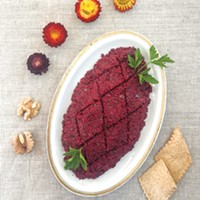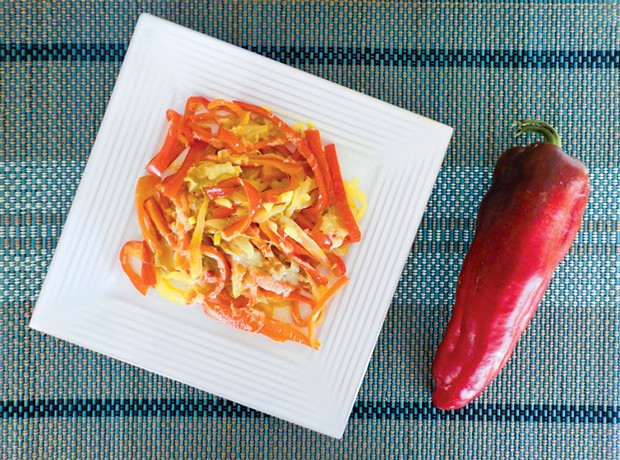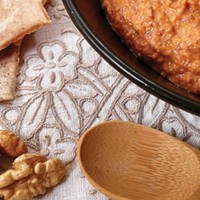[
{
"name": "Top Stories Video Pair",
"insertPoint": "7",
"component": "17087298",
"parentWrapperClass": "fdn-ads-inline-content-block",
"requiredCountToDisplay": "1"
}
]
As long as there are peppers at the farmers market, I can still believe in summer. I sort of understand how, come September, some people start feeling the pull of fall: bowls of steaming soup, glowing persimmons, roasted chestnuts. I love the warm colors of fall and my yearly pumpkin patch pilgrimage; I jump at the first apples and pears from the new crop, start hoarding winter squash as soon as they appear at the farmers market. But that does not mean I don't mourn the shortening of days and the disappearance of beloved summer produce.
As long as there are peppers, I am all right. It is hard not to be cheered by their colors, sizes and shapes at the farmers market. I remember peppers coming in definite colors: green, yellow, orange, red. The palette seems to widen every year, with purple and variegated varieties appearing at the market. Color and flavor are determined not only by the plant variety, but by the stage of ripeness when picked.
The species Capsicum annuum includes a variety of peppers, mild and hot, including bell peppers, sweet/Italian peppers, Serrano, cayenne, paprika and jalapeño. A few years ago, scientists from different disciplines combined their research data and arrived at a single hypothesis about the origin of what is the world's most widely grown spice crop. The results suggest the birthplace of the domesticated chili pepper, Capsicum annuum, may have been a region in central-east Mexico extending from southern Puebla and northern Oaxaca to southern Veracruz, and encompassing the valley of Tehuacán, farther south than previously thought.
Overall, any variety that lacks heat (which is measured with the Scoville scale) is called a sweet pepper. The blocky sweet peppers are called bell peppers. I like roasting sweet peppers for immediate and later use. In the dead of winter, when I need some bright color, I take a container of roasted peppers out of the freezer and add them to soup or side dish, or use them to make the Syrian red pepper spread muhammara ("Dip into Muhammara," Jan. 28, 2016). A flattened shape and thick flesh make round of Hungary peppers perfect for oven roasting.
Italian sweet and other peppers elongated in shape are great for cooking in a skillet. Deep crimson corno di toro (or bull's horn, for its shape) is a popular variety and there is also Carmen, described on the All-American Selections website as "sweetest when it is ripe red, but ... sweet even when immature or green." From my recent visit to the farmers market I brought home a small jewel called Violet Sparkle. Don't you love the name?
In this simple recipe, a small amount of curry powder gives peppers and onion a hint of spicy flavor. You can use the result as a side dish, to dress pasta or with eggs. You can also prepare the dish with bell peppers but why not try something new? Elongated peppers are also easier to cut for this recipe. At the farmers market, sweet and hot peppers are clearly separated, but, if in doubt, ask the farmer.
Curried Sweet Peppers
Serves 3 as a side dish.
Ingredients:
10 ounces sweet onion (such as Walla Walla or Vidalia)
13-14 ounces Italian sweet peppers (Carmen, corno di toro or other variety) or bell peppers
½ teaspoon curry powder diluted in 2 tablespoons warm water
3 tablespoons extra-virgin olive oil
2 cloves garlic, minced
½ teaspoon fine sea salt, more to taste
1 ounce freshly grated cheese, like cheddar or Cypress Grove Midnight Moon
Slice the onion lengthwise into ¼-inch sections and separate the layers into short ribbons.
Cut the peppers lengthwise. Carve out and discard the stem portion, as well as the seeds and ribbing inside. Cut each half in half crosswise and slice each piece lengthwise into ¼-inch ribbons.
Warm up the olive oil in a deep 10-inch sauté pan or large skillet on medium heat. Add the onion, stir to coat and let cook on medium-low heat for 5 minutes, stirring often. Add the garlic, stir and let cook for 1 minute.
Add the peppers and the diluted curry to the pan. Stir well, cover and cook on low heat until the peppers are tender (about 15 minutes), stirring every few minutes.
When the peppers are tender, adjust the salt and stir, then remove the pan from the heat.
Distribute the cheese over the vegetables, cover the pan again for a couple minutes to let the cheese soften. Serve immediately.
Simona
Carini (she/her) also writes about her adventures in the kitchen on her blog www.pulcetta.com.
Speaking of...
-

Mexican and Masala
Feb 29, 2024 -

Spreading Vegetable Joy
Jan 18, 2024 -

I'll Have My Spinach with Cheese and Chocolate, Please
May 11, 2023 - More »
more from the author
-
A Green Dish for Earth Day or Any Day
- Apr 18, 2024
-
Spreading Vegetable Joy
Beets for a colorful vegan starter
- Jan 18, 2024
-
A Daily Dose of Awe
- Jan 4, 2024
- More »

































